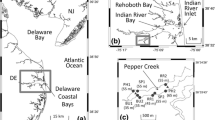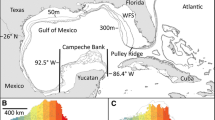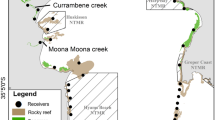Abstract
We examined connectivity among marsh subhabitats to determine the structural limits and important components of a polyhaline salt marsh by studying the patterns of abundance, residency, and movement of a numerically and ecologically dominant nektonic fish (mummichog, Fundulus heteroclitus). We captured, tagged (n = 14,040 individuals, 30–110 mm), and recaptured from Feb 2001 to Jul 2002, although most recaptures (75–95% by tagging location) occurred within 150 days. Seasonal residency and movements were common among most subhabitats based on catch per unit effort and recapture per unit effort. Thus, these (marsh pools, intertidal and subtidal creeks, and marsh surface) should be considered natural subhabitats within New England type salt marshes. Further, all these subhabitat types should be included in studies of salt marsh nekton and marsh restoration and creation activities.






Similar content being viewed by others
References
Able, K.W., and M.P. Fahay. 1998. The first year in the life of estuarine fishes in the Middle Atlantic Bight. New Brunswick: Rutgers University Press.
Able, K.W., D.A. Witting, R.S. McBride, R.A. Rountree, and K.J. Smith. 1996. Fishes of polyhaline estuarine shores in Great Bay-Little Egg Harbor, New Jersey: A case study of seasonal and habitat influences. In Estuarine shores: Evolution. Environments and human alterations, ed. K.F. Nordstrom and C.T. Roman, 335–353. Chichester: Wiley.
Able, K.W., M.P. Fahay, K.L. Heck Jr., C.T. Roman, M.A. Lazzari, and S.C. Kaiser. 2002. Seasonal distribution and abundance of fishes and decapod crustaceans in a Cape Cod estuary. Northeastern Naturalist 9(3): 285–302.
Able, K.W., L.S. Hales Jr., and S.M. Hagan. 2005. Movement and growth of juvenile (age 0 and 1+) of tautog (Tautoga onitis) and cunner (Tautogolabrus adspersus) in a southern New Jersey estuary. Journal of Experimental Marine Biology and Ecology 327(1): 22–35.
Able, K.W., S.M. Hagan, and S.A. Brown. 2006. Habitat use, movement, and growth of young of-the-year Fundulus spp. in southern New Jersey salt marshes: Comparisons based on tag/recapture. Journal of Experimental Marine Biology and Ecology 335: 177–187.
Able, K.W., J.H. Balletto, S.M. Hagan, P.R. Jivoff, and K. Strait. 2007. Linkages between salt marshes and other nekton habitats in Delaware Bay, USA. Reviews in Fisheries Science 15: 1–61.
Able, K.W., J. Dobarro, and A. Muzeni-Corino. 2010. An evaluation of boat basin dredging effects: Response of fishes and crabs in a New Jersey estuary. North American Journal of Fisheries Management 30: 1001–1015.
Adamowicz, S.C., and C.T. Roman. 2005. New England salt marsh pools: A quantitative analysis of geomorphic and geographic features. Wetlands 25(2): 279–288.
Barbier, E.B., S.D. Hacker, C. Kennedy, E.W. Koch, A.C. Stier, and B.R. Silliman. 2011. The value of estuarine and coastal ecosystem services. Ecological Monographs 81(2): 169–193.
Belanger, G., and M.A. Rodriguez. 2002. Local movement as a measure of habitat quality in stream salmonids. Environmental Biology of Fishes 64: 155–164.
Collette, B.B., and G. Klein-MacPhee (eds.). 2002. Bigelow and Schroeder’s Fishes of the Gulf of Maine. Washington: Smithsonian Institution Press.
Dahl, T.E. 1990. Wetlands losses in the United States, 1780s to 1980s. Washington: United State Department of the Interior, Fish and Wildlife Service.
Dolinsek, I.J., J.W.A. Grant, and P.M. Biron. 2007. The effect of habitat heterogeneity on the population density of juvenile Atlantic salmon Salmo salar L. Journal of Fish Biology 70: 206–214.
Fritz, E.S., W.H. Meredith, and V.A. Lotrich. 1975. Fall and winter movements and activity level of the mummichog, Fundulus heteroclitus, in a tidal creek. Chesapeake Science 16: 211–215.
Haas, H.L., C.J. Freeman, J.M. Logan, L. Deegan, and E.F. Gaines. 2009. Examining mummichog growth and movement: Are some individuals making intra-season migrations to optimize growth? Journal of Experimental Marine Biology and Ecology 369: 8–16.
Hagan, S.M., S.A. Brown, and K.W. Able. 2007. Production of mummichog Fundulus heteroclitus: Response in marshes treated for common reed Phragmites australis removal. Wetlands 27(1): 54–67.
Halpin, P.M. 1997. Habitat use patterns of the mummichog, Fundulus heteroclitus, in New England. Estuaries 20(3): 618–625.
Halpin, P.M. 2000. Habitat use by an intertidal salt-marsh fish: Trade-offs between predation and growth. Marine Ecology Progress Series 198: 203–214.
Hettler, W.F. 1989. Nekton use of regularly-flooded saltmarsh cordgrass habitat in North Carolina, USA. Marine Ecology Progress Series 56: 111–118.
Hunter, K.L., M.G. Fox, and K.W. Able. 2007. Habitat influences on reproductive allocation and growth of the mummichog (Fundulus heteroclitus) in a coastal salt marsh. Marine Biology 151: 617–627.
Hunter, K.L., M.G. Fox, and K.W. Able. 2009. Influence of flood frequency, temperature and population density on migration of Fundulus heteroclitus in semi-isolated marsh pond habitats. Marine Ecology Progress Series 391: 85–96.
Kimball, M.E., and K.W. Able. 2007a. Nekton utilization of intertidal salt marsh creeks: Tidal influences in natural Spartina, invasive Phragmites, and marshes treated for Phragmites removal. Journal of Experimental Marine Biology and Ecology 346: 87–101.
Kimball, M.E., and K.W. Able. 2007b. Tidal utilization of nekton in Delaware Bay restored and reference intertidal salt marsh creeks. Estuaries and Coasts 30(6): 1075–1087.
Kneib, R.T. 1986. Size-specific patterns in the reproductive cycle of the killifish, Fundulus heteroclitus (Pisces: Fundulidae) from Sapela Island, Georgia. Copeia 1986: 342–351.
Kneib, R.T. 1994. Spatial pattern, spatial scale and feeding in fishes. In Theory and application in fish feeding ecology, The Belle Baruch Library in Marine Science No. 18, ed. D.J. Stouder, K.L. Fresh, and R.J. Feller, 171–185. Columbia: University of South Carolina Press.
Kneib, R.T. 1997. The role of tidal marshes in the ecology of estuarine nekton. Oceanography. Marine Biology Annual Review 35: 163–220.
Kneib, R.T. 2003. Bioenergetics and landscape considerations for scaling expectations of nekton production from intertidal marshes. Marine Ecology Progress Series 264: 279–296.
Kneib, R.T., and A.H. Craig. 2001. Efficacy of minnow traps for sampling mummichogs in tidal marshes. Estuaries 24(6A): 884–893.
Kneib, R.T., and S.L. Wagner. 1994. Nekton use of vegetated marsh habitats at different stages of tidal inundation. Marine Ecology Progress Series 106: 227–238.
Lathrop, R.G., M.B. Cole, and R.D. Showalter. 2000. Quantifying the habitat structure and spatial pattern of New Jersey (USA) salt marshes under different management regimes. Wetlands Ecology and Management 8: 163–172.
Lotrich, V.A. 1975. Summer home range and movements of Fundulus heteroclitus (Pisces: Cyprinodontidae) in a tidal creek. Ecology 56: 191–198.
Minello, T.J., R.J. Zimmerman, and R. Medina. 1994. The importance of edge for natant macrofauna in a created salt marsh. Wetlands 14(3): 184–198.
Minello, T.J., K.W. Able, M.P. Weinstein, and C.G. Hays. 2003. Salt marshes as nurseries for nekton: Testing hypotheses on density, growth, and survival through meta-analysis. Marine Ecology Progress Series 246: 39–59.
Mitsch, W.J., and J.G. Gosselink. 1993. Wetlands. New York: Van Nostrand Reinhold.
Nemerson, D.M., and K.W. Able. 2003. Spatial and temporal patterns in the distribution and feeding habits of Morone saxatilis, in marsh creeks of Delaware Bay, USA. Fisheries Management and Ecology 20: 337–348.
Peterson, C.H., K.W. Able, C.F. DeJong, M.F. Piehler, C.A. Simenstad, and J.B. Zedler. 2008. Practical proxies for tidal marsh ecosystem services: Application to injury and restoration. In Advances in marine biology, vol. 54, ed. D.W. Sims, 221–266. San Diego: Elsevier.
Redfield, A.C. 1972. Development of a New England salt marsh. Ecological Monographs 42(2): 201–237.
Roman, C.T., K.B. Raposa, S.C. Adamowica, M.J. James-Pirri, and J.G. Catena. 2002. Quantifying vegetation and nekton response to tidal restoration of a New England salt marsh. Restoration Ecology 10: 450–460.
Rountree, R.A. 1992. Fish and macroinvertebrate community structure and habitat use patterns in salt marsh creeks of southern New Jersey, with a discussion of marsh carbon export. Ph.D. dissertation, Rutgers, The State University of New Jersey, New Brunswick, NJ
Rountree, R.A., and K.W. Able. 1992. Foraging habits, growth, and temporal patterns of salt-marsh creek habitat use by young-of-year summer flounder in New Jersey. Transactions of the American Fisheries Society 121: 765–776.
Rountree, R.A., and K.W. Able. 2007. Spatial and temporal habitat use patterns for salt marsh nekton: Implications for ecological functions. Aquatic Ecology 41: 25–45.
Rozas, L.P., and C.T. Hackney. 1983. The importance of oligohaline estuarine wetland habitats to fisheries resources. Wetlands 3: 77–89.
Ruiz, G.M., A.H. Hines, and M.H. Posey. 1993. Shallow water as a refuge habitat for fish and crustaceans in non-vegetated estuaries: An example from Chesapeake Bay. Marine Ecology Progress Series 99: 1–16.
Schick, R.S., S.R. Loarie, F. Colchero, B.D. Best, A. Boustany, D.A. Conde, P.N. Halpin, L.N. Joppa, C.M. McClellan, and J.S. Clark. 2008. Understanding movement data and movement processes: Current and emerging directions. Ecology Letters 11: 1338–1350.
Secor, D.H., and J.R. Rooker. 2005. Connectivity in the life histories of fishes that use estuaries. Estuarine, Coastal and Shelf Science 64: 1–3.
Smith, K.J., and K.W. Able. 1994. Salt-marsh tide pools as winter refuges for the mummichog, Fundulus heteroclitus, in New Jersey. Estuaries 17(1B): 226–234.
Smith, K.J., G. Taghon, and K.W. Able. 2000. Trophic linkages in marshes: Ontogenetic changes in diet for young-of-the-year mummichog, Fundulus heteroclitus. In Concepts and controversies in tidal marsh ecology, ed. M.P. Weinstein and D.A. Kreeger, 221–237. The Netherlands: Kluwer.
Suk, N.S., Q. Guo, and N.P. Psuty. 1999. Suspended solids flux between salt marsh and adjacent bay: a long-term continuous measurement. Estuarine, Coastal and Shelf Science 49: 61–81.
Teo, S.L.H., and K.W. Able. 2003a. Growth and production of the mummichog (Fundulus heteroclitus) in a restored salt marsh. Estuaries 26(1): 51–63.
Teo, S.L.H., and K.W. Able. 2003b. Habitat use and movement of the mummichog (Fundulus heteroclitus) in a restored salt marsh. Estuaries 26(3): 720–730.
Tupper, M., and K.W. Able. 2000. Movements and food habits of striped bass (Morone saxatilis) in Delaware Bay (USA) salt marshes: Comparison of a restored and a reference marsh. Marine Biology 137(5/6): 1049–1058.
Turchin, P. 1998. Quantitative analysis of movement: Measuring and modeling population redistribution in animals and plants. Sunderland: Sinauer Associates, Inc.
Vanreusel, W., and H. Van Dyck. 2007. When functional habitat does not match vegetation types: A resource-based approach to map butterfly habitat. Biological Conservation 135: 202–211.
Weinstein, M.P., and J.H. Balletto. 1999. Does the common reed, Phragmites australis, affect essential fish habitat? Estuaries 22(3B): 793–802.
Weinstein, M.P., J.M. Teal, J.H. Balletto, and K.A. Strait. 2001. Restoration principles emerging from one of the world’s largest tidal marsh restoration projects. Wetlands Ecology and Management 9: 387–407.
Winker, K., J.H. Rappole, and M.A. Ramos. 1995. The use of movement data as an assay of habitat quality. Oecologia 101: 211–216.
Zedler, J.B. 2001. Handbook for restoring tidal wetlands. Boca Raton: CRC.
Acknowledgments
All techniques used in this study were conducted under Rutgers University Animal Use Protocol no. 88–042. Numerous individuals from the Rutgers University Marine Field Station (RUMFS) assisted in the tagging and recapture over several seasons. Karen Hunter helped with the data compilation and analysis. Two anonymous reviewers provided helpful comments on an earlier draft. This study was supported by RUMFS and is Rutgers University Institute of Marine and Coastal Sciences Contribution no. 2012-2.
Author information
Authors and Affiliations
Corresponding author
Additional information
Stacy M. Hagan is posthumous
Rights and permissions
About this article
Cite this article
Able, K.W., Vivian, D.N., Petruzzelli, G. et al. Connectivity Among Salt Marsh Subhabitats: Residency and Movements of the Mummichog (Fundulus heteroclitus). Estuaries and Coasts 35, 743–753 (2012). https://doi.org/10.1007/s12237-011-9471-x
Received:
Revised:
Accepted:
Published:
Issue Date:
DOI: https://doi.org/10.1007/s12237-011-9471-x




